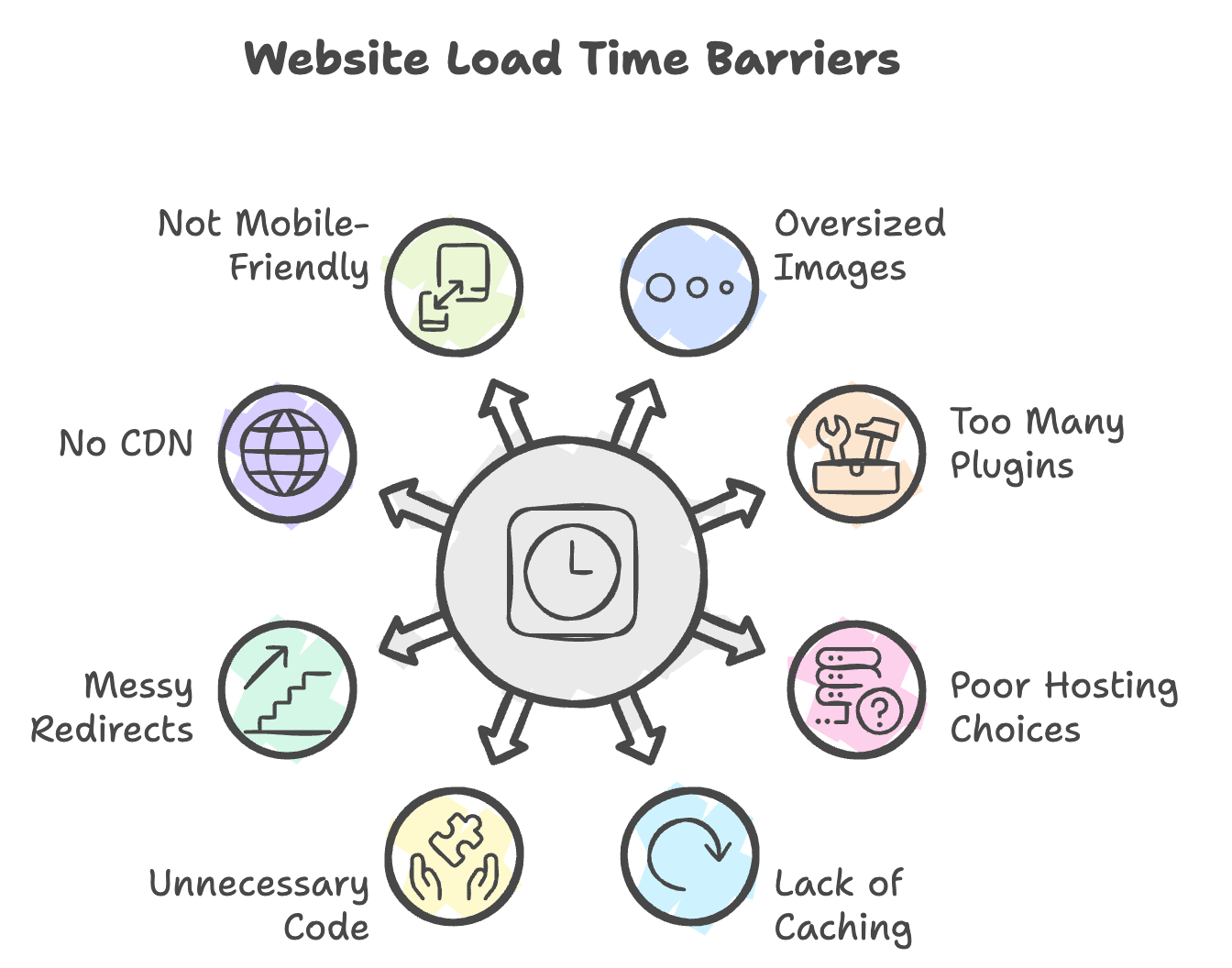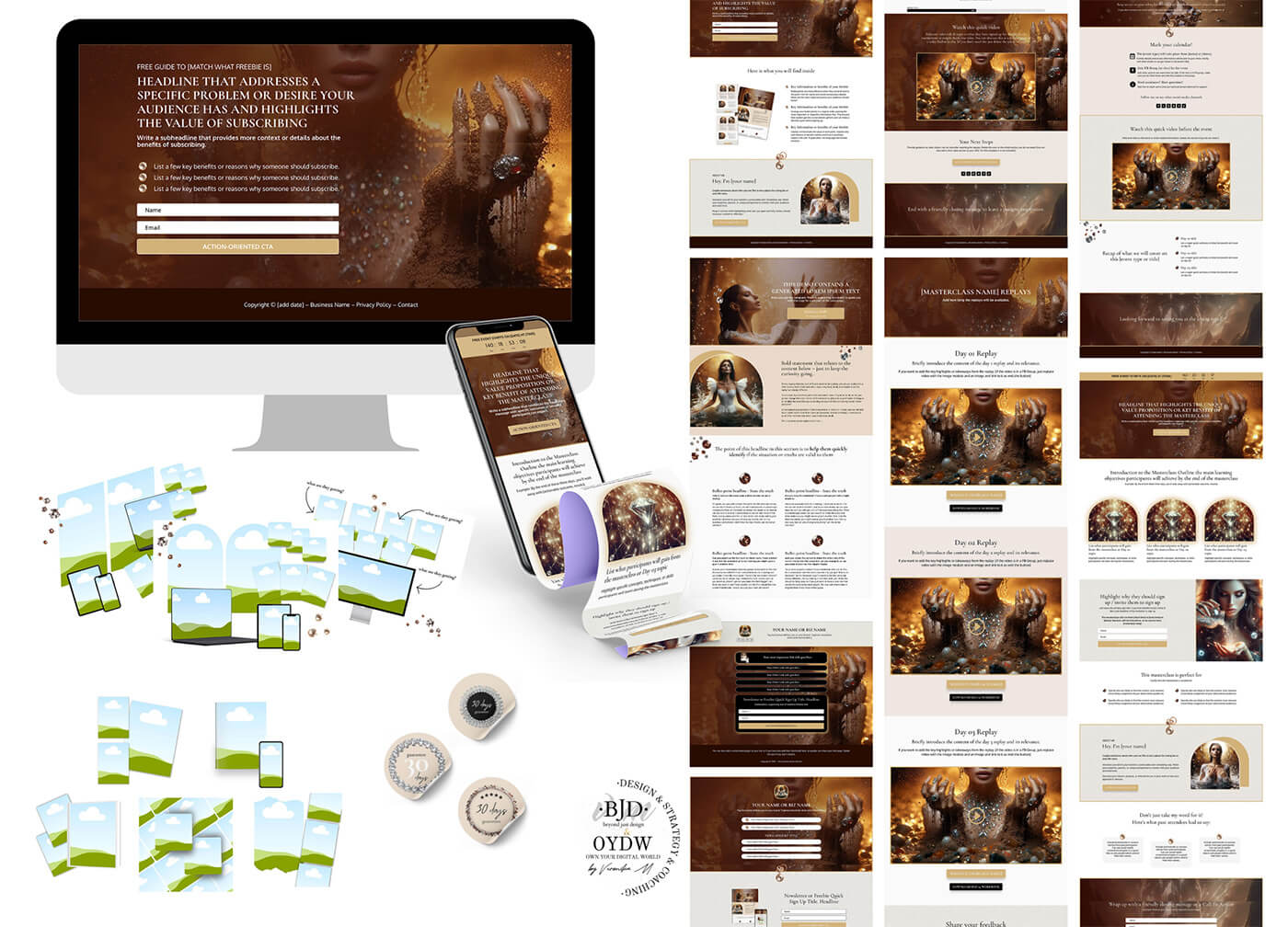Why Website Speed is Crucial for Your Business
If you’re a small business owner that also manages their own website & funnels, chances are you’ve seen posts in Facebook groups or forums asking, “Why is my website so slow?” or “How can I make my website and funnel pages load faster?” or maybe your own website and funnel pages are suffering the same symptoms and you are asking the exact same questions.
It’s a common frustration…..for a good reason and today I felt like writing about it to help you understand why your site might be slow and what the heck to do about it!
And
This is especially true for WordPress websites with sales funnels, where every second of delay can directly impact your revenue. While WordPress powers over 40% of all websites and is fantastic for building sales funnels, it needs proper optimization to perform at its best and turn visitors into customers efficiently.
Your website’s speed directly impacts your customers’ first impressions, your ability to generate sales, and even your visibility on search engines. Imagine someone lands on your site eager to learn about your business, but instead of being impressed by what you offer, they’re left waiting as your pages load.
Most people won’t stick around – 53% of visitors abandon a website that takes longer than 3 seconds to load and a 1-second delay can lead to 7% fewer conversions and up to 16% less customer satisfaction.
To put this into perspective: if your website generates $10,000 in monthly revenue, that 7% loss in conversions could mean you’re leaving $700 on the table every month – that’s $8,400 a year! And this doesn’t even account for the long-term impact of frustrated customers who may never return to your site.
Website speed doesn’t just affect your visitors’ experience – it can also make or break your sales funnel pages. A slow-loading site can interrupt critical steps in your funnel, like capturing leads, completing purchases, or signing up for services. Each second of delay could cost you potential customers who might abandon the process altogether. It is also a critical factor for SEO. Google prioritizes faster websites in search rankings, and if your site is slow, you could be losing out to competitors.
Table of Contents

Don’t worry, though!
Optimizing your site doesn’t require an advanced technical degree.
Slow websites don’t happen by accident. Here are some of the usual suspects:
Oversized Images
Large, unoptimized images are like carrying extra luggage—they slow everything down. If your site is full of big image files, it takes longer for your visitors to see the page.
Too Many Plugins
Plugins are great for adding features to your website, but too many of them can clog up the system, especially if they’re outdated or poorly coded.
Poor Hosting Choices
If your website’s hosting provider isn’t up to speed, literally, it doesn’t matter how well-optimized your site is. Shared hosting plans, in particular, can slow things down.
Lack of Caching
When your site doesn’t save temporary data, it has to load everything from scratch each time.
Unnecessary Code
Behind every website is a lot of code. If there’s extra or messy code, it can take longer to process and deliver the page to your visitors.
Messy Redirects
URLs are going over loops to arrive at their destination.
No Content Delivery Network (CDN)
Visitors far from your hosting server may experience slower load times.
Not Mobile-Friendly
Many customers browse on their phones, and if your website isn’t optimized for mobile, it might load slower or display incorrectly.
Not Testing Site Regularly
Checking your website speed periodically ensures you’re staying on track.

Before Implementing Changes
Backup Your Website First
Before making any major changes to your website, always create a backup. This ensures that if something goes wrong—like a plugin conflict or a coding error—you can quickly restore your site to its previous state.
How to Backup Your Website
- Manual Backups: If your hosting provider offers a control panel like cPanel, you can manually download your website files and database.
- Free Plugins: Use plugins like UpdraftPlus to automate backups. It allows you to store backups on cloud services like Google Drive or Dropbox.
- Best Practice: Schedule regular automatic backups (e.g., weekly or daily), especially if you frequently update your website.
How to Make Your Website And Sales Funnel Pages Faster
Now, let’s get to it!
Here are some practical tips you can apply—even if you’re not a tech wizard!
1. Resize and Compress Your Images
Images are often the largest files on a webpage, and large file sizes mean slower loading.
Optimized images ensure that landing pages load quickly, so prospects don’t abandon your sales funnel before seeing your offers.
Solution 1: Compress Your Images
Tools like TinyPNG or ImageOptim reduce image file sizes without noticeable quality loss. I personally use TinyPNG all the time before finalizing any website and funnel pages.
Solution 2: Choose the Right Format
- Use JPEG for photographs.
- Use PNG for logos or graphics with transparency.
- For advanced optimization, consider WebP, a newer format that provides great quality at smaller sizes.
- Free Plugin: Smush for WordPress automatically compresses images as you upload them.
Solution 3: Use Responsive Images
Set your images to adjust based on the visitor’s device and screen size. Many ‘new generation’ page builders like Divi, Elementor, Oxygene, Breakdance etc. offer built-in features for this.
Solution 4: Enable Lazy Loading
Lazy loading ensures that only the images or videos visible on a visitor’s screen load initially, speeding up the first impression.
- Free Plugin: Use plugins like Smush or Lazy Load by WP Rocket to enable this feature.
2. Streamline Your Plugins
Plugins can enhance functionality, but they can also slow things down if not managed properly.
Solution 1: Audit and Remove Unnecessary Plugins
Review your plugins regularly. If one isn’t serving a clear purpose, uninstall it.
Free Tool: Use the WordPress dashboard’s “Inactive Plugins” section to identify unused plugins.
Solution 2: Use Lightweight Plugins
Look for streamlined plugins that offer only what you need. For instance, RankMath SEO is a lightweight alternative to bulkier plugins like Yoast SEO.
Solution 3: Keep Plugins Updated
Outdated plugins may contain inefficient code or compatibility issues that slow your site. Always update to the latest version.
3. Upgrade Your Hosting
Your hosting provider is the foundation of your website’s speed. While most of us use Shared Hosting and can achieve great loading speeds, if you just can’t find a solution and maybe your website has a lot of things on [like a shop with many features and products, funnels, blog and the whole nine yards] you have options to end the slow loading-ness buy changing hosts.
While shared hosting might save you $10-20 per month, the cost of lost sales from slow loading times could far exceed these savings. Even a modest improvement in load time could recover hundreds in lost revenue – making better hosting one of the most cost-effective investments for your business.
Solution 1: Switch to Managed Hosting
Managed hosting, offered by companies like WP Engine or Kinsta, is optimized for speed and reliability.
Solution 2: Use a VPS or Dedicated Server
Virtual Private Servers (VPS) or dedicated hosting plans are faster than shared hosting, which splits resources among multiple websites.
Solution 3: Leverage Cloud Hosting
Services like Amazon AWS or Google Cloud offer scalable hosting options that adjust based on your traffic needs.
Take note: managed hosting ,VPS and Dedicated Servers often cost more than Shared hosting… I have been using Namecheap Hosting for years without much issues [this site is a bit slower than the other and the reason goes back to switching main domain on my hosting account – it’s a long story] but I am still happy with the hosting so will be sticking around for couple more years 🙂
4. Implement Caching
Caching helps by storing temporary copies of your website so that returning visitors don’t have to reload everything.
By using caching plugins, you can significantly reduce load times during high-traffic periods. This is especially important if your sales funnel includes steps like checking out or downloading resources, where any delay can lead to drop-offs.
For WordPress sites running sales funnels, caching is particularly crucial. Each step in your funnel – from opt-in pages to checkout – needs to load lightning-fast to maintain momentum and prevent drop-offs. A well-cached WordPress funnel can significantly boost completion rates, turning more visitors into leads and customers.
Solution 1: Use Caching Plugins
For WordPress, plugins like WP Rocket, WP Super Cache, or W3 Total Cache can handle caching automatically.
Solution 2: Browser Caching
Encourage visitors’ browsers to save certain site elements locally. This reduces the need to load all resources repeatedly.
Solution 3: Server-Side Caching
Many hosting providers offer server-side caching as part of their services. Check with your provider to see if this option is available.
5. Minimize and Clean Up Your Code
Extra or messy code can take longer to process and deliver the page to your visitors.
Solution 1: Minify CSS, HTML, and JavaScript
Minification removes spaces, comments, and other unnecessary characters in code. Tools like Autoptimize or WpOptimize plugins can handle this for you.
Solution 2: Remove Unused CSS or Scripts
Use tools like Google Chrome DevTools to identify unused code and remove it.
Solution 3: Asynchronous Loading
Enable asynchronous loading for scripts so they don’t block the page from loading while waiting for the code to execute.
6. Reduce Redirects
Redirects are like road detours – they slow users down. Redirects are necessary sometimes but can add extra steps that slow down loading.
Solution 1: Audit Your Redirects
Use tools like Screaming Frog SEO Spider to identify and eliminate unnecessary redirects.
Solution 2: Avoid Chains
Redirect chains (one redirect pointing to another) add unnecessary delays. Try to minimize them by ensuring your URLs point directly to the correct content.
7, Use a Content Delivery Network (CDN)
A CDN delivers content from the server closest to the visitor, reducing the time it takes for data to travel.
Solution 1: Free CDNs
Cloudflare offers free CDN services that are perfect for small business websites.
Solution 2: Premium CDNs
For high-traffic sites, premium CDNs like Akamai or KeyCDN provide faster speeds and enhanced features.
8, Regularly Test Your Site And Speed
Neglecting regular speed tests can lead to creeping performance issues that silently eat away at your profits. Consider this: if your site gradually slows down over a few months, you might not notice it, but your revenue numbers will. Many businesses discover they’ve been losing thousands in potential sales only after investigating sudden drops in conversion rates.
While speed is essential, a fast website isn’t helpful if it’s hard to navigate or riddled with errors. Regular usability testing ensures your site performs well across devices and browsers, and functions as intended.

Don’t Just Speed-Test: Check Usability and Glitches Too!
How to Test Usability and Spot Glitches
- Browser Testing: Use tools like BrowserStack to see how your site looks and behaves on different browsers and devices.
- Check Links: Use free tools like Broken Link Checker to find and fix broken links.
- Gather Feedback: Ask friends, family, or customers to browse your site and report any issues they encounter.
By including these steps as part of your regular maintenance routine, you’ll ensure your website remains fast, user-friendly, and glitch-free over time.
Tools to Monitor and Improve Website & Funnel Pages Speed
After implementing these strategies, you’ll want to keep an eye on your performance. Here are some helpful tools:
- Google PageSpeed Insights
Analyzes your site and provides specific suggestions for improvement. - GTmetrix
Offers detailed performance reports, including load times and optimization tips. - Pingdom Website Speed Test
Provides an easy-to-read breakdown of what’s slowing down your site.
Why Mobile Optimization Is Essential for Speed and Sales Funnels
Did you know that over 60% of web traffic now comes from mobile devices?
With over 60% of traffic coming from mobile devices, poor mobile optimization isn’t just about user experience – it’s about your bottom line. Businesses lose an estimated 70% of potential mobile sales due to poor performing websites. If you’re spending money on advertising to mobile users, but your site loads slowly on phones, you’re essentially paying for traffic that’s likely to bounce before converting.
Mobile users expect fast, seamless experiences, and any delay – whether on your homepage or at a critical step in your sales funnel – can cause them to abandon your site entirely.
Impact on Sales Funnels
Mobile optimization is especially crucial for your sales funnel. Think about these stages:
- Landing Pages: If your landing pages take too long to load or don’t fit smaller screens, visitors might bounce before entering your funnel.
- Lead Capture Forms: Forms that aren’t mobile-friendly, such as ones requiring excessive zooming or scrolling, lead to fewer sign-ups.
- Checkout Process: For e-commerce businesses, a slow or poorly designed mobile checkout can lead to cart abandonment, costing you sales.
How to Optimize for Mobile
- Use Responsive Design: Ensure your website is responsive, meaning it automatically adjusts to fit screens of all sizes.
- Test for Mobile Speed: Use tools like Google’s Mobile-Friendly Test to ensure your site performs well on phones and tablets.
- Simplify Forms and Buttons: Make sure forms are easy to fill out on a small screen, and that buttons are large enough to click without frustration.
- Prioritize Mobile Navigation: Ensure menus and key pages are easy to access. Hidden or hard-to-find options can disrupt your funnel.
A Word of Caution About Mobile View
While many website platforms and tools, such as WordPress themes or drag-and-drop page builders, promise “mobile responsiveness,” it’s important to test and fine-tune the mobile version of your site manually. Out-of-the-box settings don’t always translate well to smaller screens, which could result in broken layouts, overlapping text, or buttons that are hard to tap.
Here’s What to Watch For:
- Text and Images Overlapping: Certain themes might display perfectly on desktop but look cluttered or misaligned on mobile.
- Hard-to-Click Buttons or Links: Make sure buttons are large and spaced far enough apart to be easily clickable on small screens.
- Hidden Content: Some themes automatically hide sections on mobile, potentially removing crucial parts of your sales funnel (e.g., a call-to-action button or a lead capture form).
How to Fix It:
- Preview and Edit the Mobile Version: Most page builders, like Elementor or Divi, have a mobile view editor. Always check this and make adjustments specific to mobile devices.
- Test Across Devices: Don’t rely on just one phone or browser to test your site. Use tools like BrowserStack or Google DevTools to preview your site across different devices.
- Customize Manually if Needed: Be ready to tweak fonts, margins, and padding manually in the mobile view settings to ensure everything looks polished.
If you’re building a mobile-friendly sales funnel and want a head start, check out my Divi Sales Funnel Templates or Elementor Funnel Designs. These templates are fully customizable and designed to load quickly on all devices.
The cost of inaction adds up quickly: slower sites mean higher bounce rates, lower conversion rates, and wasted advertising spend. If you’re investing in marketing but ignoring site speed, it’s like filling a leaky bucket – you’re losing potential customers (and money) at every slow-loading page. For example, if you’re spending $1,000 on ads monthly but your site takes 5+ seconds to load, you could be wasting up to 40% of that budget on visitors who leave before your page finishes loading.
The Payoff: Why a Faster Website & Funnel Pages Change Everything
Investing time in improving your website’s speed isn’t just about making it look good—it’s about creating an experience that keeps customers engaged. A faster site means:
- Higher Conversions: Visitors are more likely to become paying customers. Studies show that websites loading under 2 seconds have almost double the conversion rate of slower sites. For an e-commerce site making $100,000 annually, this speed difference alone could mean an additional $50,000-$80,000 in yearly revenue.
- Better Search Rankings: Google rewards faster websites with higher visibility.
- Happier Customers: People love websites that work as fast as they do.
For WordPress users running sales funnels, these optimizations are game-changers. A properly optimized WordPress funnel can maintain consistent conversion rates even during high-traffic promotions or launches, ensuring you capitalize on every marketing effort. While an unoptimized funnel might convert at 1-2%, a fast, well-optimized funnel could see conversion rates of 3-5% or higher – potentially doubling or tripling your revenue from the same traffic.
It’s no surprise that the question “How can I speed up my website?” is constantly being asked in online communities. Now that you have a roadmap with free tools and plugins, you’re equipped to tackle the issue.
And let’s not forget that speed is also critical at every stage of your sales funnel. [maybe even more so than a website especially if you are sending high volume traffic to it ] Whether someone is entering their email in exchange for a lead magnet, browsing your product pages, or completing a purchase, a slow website is a dealbreaker. By optimizing for speed, you’re not just improving usability—you’re keeping your funnel flowing smoothly and maximizing conversions.
Start small – optimize your images or install a caching plugin – and build from there.
The beauty of WordPress is its flexibility in creating powerful sales funnels – but that power needs to be properly harnessed. When your WordPress site and funnel pages are optimized for speed, they become a seamless sales machine, working 24/7 to convert visitors into customers. Every second you shave off your loading time could mean thousands more in revenue over the course of a year.
Your Turn!
What will you try first to make your website faster? Share your results in the comments below or join the conversation. Let’s make the web a speedier place, one site at a time!
Speed and design go hand-in-hand when it comes to successful sales funnels. Don’t leave your conversions to chance – start with a professionally designed, fast-loading template. Check out my Divi Templates and Elementor Templates to get started today!


0 Comments